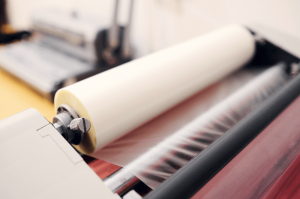With document lamination, you apply a durable plastic film to the exterior of documents. This offers a layer of protection. It enables the material to resist tears, wrinkles, scuffs, moisture, and dirt. Laminating services are a great investment if you want to make the products last longer.
To gain the maximum benefit, the laminate most commonly gets applied to both sides of your printed piece. Laminates come in all sorts of sheen levels and thicknesses. Moreover, there are two primary kinds of edge finishing to choose from; a flush cut edge and a sealed edge. Our aim here is to explore the two in more detail to help you understand them better.
Sealed edge laminate
 To produce a sealed edge, both the bottom and top sheets of the laminate film have to be slightly bigger than the printed piece. This enables both laminate sheets to extend beyond the edges on all sides. What happens is the films bond tightly to both sides of the document and also to one another where they meet around the whole perimeter of the piece.
To produce a sealed edge, both the bottom and top sheets of the laminate film have to be slightly bigger than the printed piece. This enables both laminate sheets to extend beyond the edges on all sides. What happens is the films bond tightly to both sides of the document and also to one another where they meet around the whole perimeter of the piece.
A sealed-edge laminate tends to overhang the printing by 1/8″ on every side. However, the amount of overhang can be 1/2″, 3/8″, 1/4″ or whatever amount a client wants for their project.
The main benefit of this method is that it encloses the whole document with plastic. As its name suggests, the perimeter edge is sealed entirely. So, no moisture, grime, or other contaminants can reach the paper or ink. Come to us if you’re in need of first rate laminating services.
Flush cut laminate
The second method utilises a laminate sheet that is bonded to both sides of a printed piece to safeguard it. As its name implies though, the method consists of trimming so the plastic film is flush with the paper’s edge. What you end up with is a very clean edge.
The main benefit here is how aesthetically pleasing it is. The laminate doesn’t extend past the paper in the way it does with the other approach. But, this means the flush cut leaves a potential vulnerability at the edges. Spills and stains could become an issue. Peeling may also be a concern.
Which is best?
As for which of the two methods is superior, it mainly comes down to the kind of project. Personal preference also matters. If your main concern is protection, you should go for a sealed edge laminate. You will have a more complete seal. If visual appeal and clean edges is what you need though, consider using a flush cut laminate.
For those curious about costs, both methods are affordable. Saying this, a flush edge will cost you less. Sealed edge laminate costs more because of additional production steps. You need to trim twice to get a great finish. Conversely, flush cut only requires trimming once.
Ask about our laminating services
At Foiling Services, we’ve worked our way up to becoming a leading authority on lamination. Our team understands how best to supply reliable services. As a result, we can offer exceptional solutions for a variety of needs.
So, if you’re interested in finding out more about laminating services, feel free to talk to us. We have access to exceptional films, including sustainable ones.
